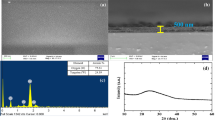Abstract.
The characterisation of electrochemical behaviour of electrochromic (EC) devices based on solution thermolysed (ST) tungsten oxide (WO3) thin films was carried out using the step potential excitation method. The method, based on generating plots of current density (J) as a function of passed charge (ΔQ), has been applied for the characterisation of EC-WO3 thin films in proton-containing aqueous electrolyte. EC devices have been fabricated by employing WO3 thin films with variable thickness (T) ranging from 0.04 to 0.52 µm. The J vs time (t) responses (chronoamperometry) of these devices were recorded at a fixed applied potential (±0.7 V vs S.C.E.) and values of total passed H+ charges (ΔQ) into the WO3 host lattice during the coloration process are calculated. The J-ΔQ curves corresponding to films of different thickness were plotted as a function of the passed charge volume density, ΔQ /T, and an intercalatable film thickness is calculated to be 0.13 µm. The modulation in optical transmittance after coloration and bleaching was studied in the wavelength range between 350 and 850 nm and an optical efficiency (ξλ) is calculated at λ=700 nm. It is found that the ξλ wanes with increasing intercalation.
Similar content being viewed by others
Author information
Authors and Affiliations
Additional information
Electronic Publication
Rights and permissions
About this article
Cite this article
Patil, P. Solution thermolysed tungsten oxide-based electrochromic devices: thickness-dependent step potential analysis. J Solid State Electrochem 6, 284–287 (2002). https://doi.org/10.1007/s100080100232
Received:
Accepted:
Published:
Issue Date:
DOI: https://doi.org/10.1007/s100080100232




